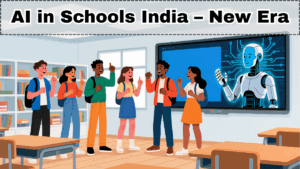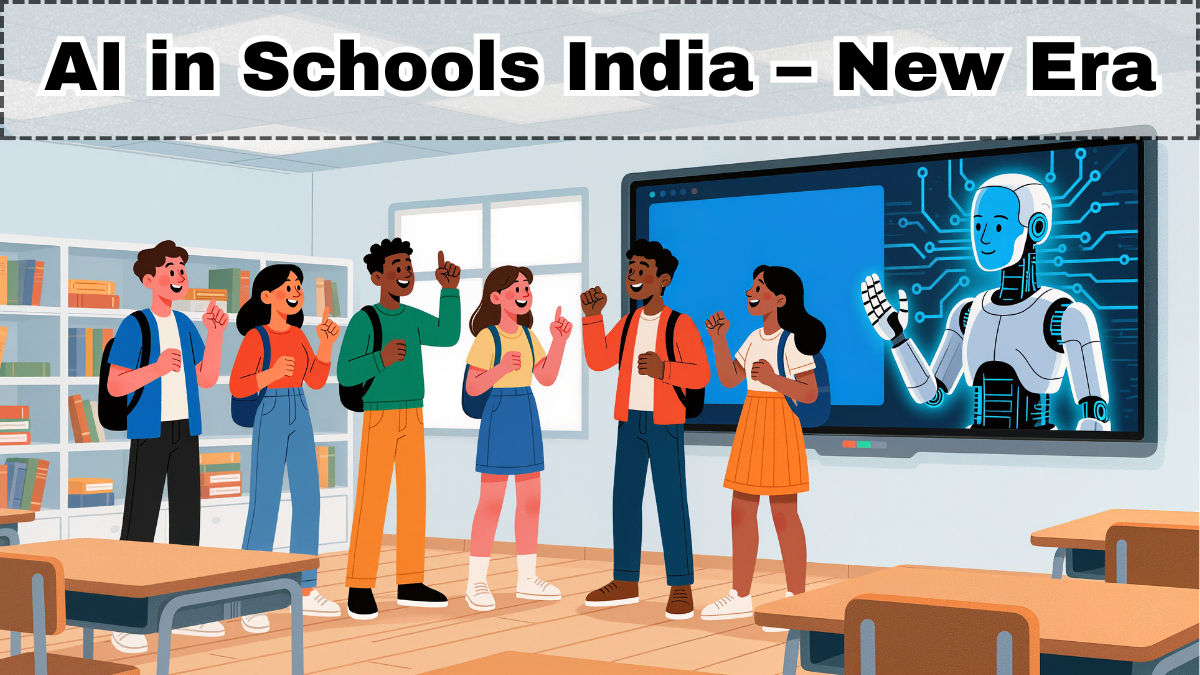Education in India is undergoing a massive transformation, and AI in Schools India 2025 represents the biggest shift in how students learn, teachers teach, and classrooms operate. Artificial Intelligence has moved from being a futuristic idea to an active part of India’s school ecosystem, improving accessibility, personalizing learning, and making classrooms smarter than ever before.
With NEP 2020 encouraging digital innovation and EdTech companies partnering directly with schools, AI-powered systems are now being implemented across urban and rural institutions. From automated attendance to AI tutors, from smartboards to data-driven lesson planning, 2025 marks the beginning of an intelligent and more inclusive education model for Indian students.

How AI Is Transforming Classrooms in 2025
Modern Indian classrooms now use AI-driven tools to support teaching and learning. Schools are adopting digital boards, cloud-based content, and smart assessment systems. AI handles tasks that traditionally consumed teacher time — like checking assignments, organizing lesson plans, and tracking academic progress.
Students benefit from personalized learning paths. AI evaluates learning patterns and offers customized explanations, practice questions, and difficulty levels. Slow learners receive extra support, while fast learners move ahead without waiting for the whole class.
AI is also introducing immersive environments through interactive simulations, VR-backed lessons, and voice-based learning assistance. Combined, these technologies create a hybrid classroom where digital and physical education blend seamlessly.
AI Tools Most Commonly Used in Schools
Below is a simplified table showing how AI tools are transforming different aspects of schooling:
| AI Tool | Purpose | Impact in Schools |
|---|---|---|
| AI Tutors | One-on-one learning support | Personalized understanding |
| Smart Attendance | Facial recognition or QR system | Saves time, prevents errors |
| Automated Assessments | Instant answer-checking | Faster grading, better feedback |
| Adaptive Learning Apps | Customized difficulty levels | Better learning outcomes |
| Virtual Labs | Science & math experiments | Hands-on learning digitally |
These tools highlight how AI is improving efficiency and student engagement across India.
Personalized Learning – The Biggest Evolution
Personalization is at the core of AI in Schools India 2025. Every student learns differently, and AI identifies each child’s strengths, weaknesses, and pace. Using this analysis, AI-generated learning plans allow students to absorb concepts in a way that suits them best.
For example, AI can identify which student struggles with maths fractions and assign them extra videos, quizzes, and interactive problems. Similarly, students excellent in science receive advanced-level content to push their abilities further.
This approach removes the “one-size-fits-all” problem from education and creates a more inclusive environment.
Smarter Teaching Support for Teachers
Contrary to the misconception, AI is not replacing teachers. Instead, it’s becoming their most powerful assistant. Teachers save valuable time as AI manages repetitive tasks like:
• Checking multiple-choice answers
• Preparing worksheets
• Scheduling lessons
• Detecting learning gaps
Teachers use this saved time to focus on creativity, student mentorship, and conceptual explanation — tasks that require human touch. AI also provides reports that help teachers identify which students need more attention.
AI in Exams and Assessment Systems
Exams are being redesigned using AI-based question banks and adaptive difficulty systems. Students receive a mix of easy, medium, and hard questions based on their performance. AI checks objective-type answers instantly and provides detailed insights like time spent per question, accuracy patterns, and topic-wise performance.
Schools use this data for targeted revision classes and improved exam strategies.
Digital Classrooms – A New Standard
Digital classrooms became widespread after the pandemic, but in 2025 they have evolved into AI-driven smart environments. Interactive boards display 3D models, experiments, and animated lessons. Students engage with learning material through voice commands, touch controls, and instant doubt-solving assistants.
AI-powered translation tools help schools support multilingual classes, breaking regional language barriers. Rural schools benefit highly as digital classrooms bring quality learning materials at par with top institutions.
AI for Student Safety and Well-being
AI is also being used for safety and emotional health. Many schools now use AI-powered monitoring systems to identify signs of bullying, stress, or unusual behavioral patterns. Smart ID cards, GPS-enabled buses, and real-time alerts keep parents and school authorities informed.
Emotional AI tools offer mindfulness exercises and mood-based activities to help students manage stress.
Challenges Schools Face While Adopting AI
Despite the rapid growth, schools encounter challenges such as high device costs, need for strong internet, and teacher training gaps. Many rural schools require government support to upgrade infrastructure. Data privacy and cybersecurity continue to be critical concerns as more student information goes online.
However, continuous policy improvements and growing affordability of EdTech devices are helping solve these issues.
How AI Is Shaping the Future of Learning in India
AI-backed education promotes curiosity, creativity, and independent thinking. Students learn with visualizations, simulations, and real-time feedback rather than memorizing information. Teachers grow into facilitators who guide thinking instead of just delivering content.
By 2026, AI may integrate deeper into vocational training, coding programs, STEM labs, and virtual internships. With India’s strong digital adoption, schools are well-positioned to become global leaders in AI-driven education.
FAQs
Is AI replacing teachers in Indian schools?
No. AI supports teachers by handling routine tasks, letting them focus on teaching and student interaction.
Can AI improve student performance?
Yes, personalized learning paths help students learn at their own pace, improving results significantly.
Do rural schools benefit from AI?
Absolutely. Digital classrooms and AI tools bring high-quality teaching to remote areas as well.
Are AI tools safe for children?
Modern systems use strict privacy controls, and schools follow guidelines to protect student data.
What subjects benefit most from AI?
Maths, science, languages, and coding see the highest improvement due to adaptive content and visual learning.
Click here to know more.
